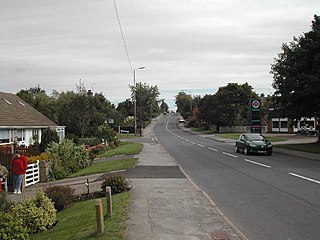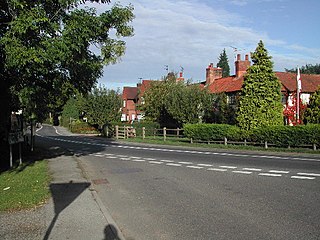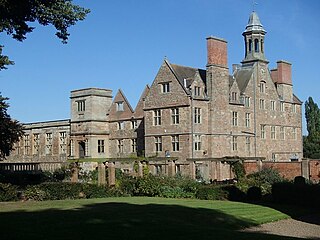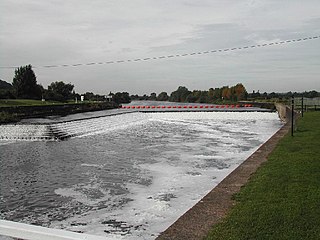
Calverton is a village and civil parish in Nottinghamshire, England and of some 4,247 acres in size. It is in the Gedling district, about 7 miles (11 km) north-east of Nottingham, 10 miles (16 km) south-east of Mansfield, and situated, like nearby Woodborough and Lambley, on one of the small tributaries of the Dover Beck. The 2021 census found 7,282 inhabitants in 3,120 households. About 2 miles (3.2 km) miles to the north of the village is the site of the supposed deserted settlement of Salterford.

The A614 is a main road in England running through the counties of Nottinghamshire, South Yorkshire and the East Riding of Yorkshire.

Sherwood Forest is a constituency represented in the House of Commons of the UK Parliament since 2024 by Michelle Welsh, of the Labour Party. The constituency's name is shared with Sherwood Forest, which is in the area.

Wellow is a village in Nottinghamshire, England. According to the 2001 census it had a population of 444, increasing to 470 at the 2011 census, but falling slightly to 463 at the 2021 census.

Bilsthorpe is a village and civil parish in the Newark and Sherwood district of Nottinghamshire, England. According to the 2001 census it had a population of 3,076, increasing to 3,375 at the 2011 census, and dropping slightly to 3,365 at the 2021 census. It is located near the junction of the A614 and A617, around 5 miles south of Ollerton, 9 miles east of Mansfield and 6 miles north-west of Southwell.

Rainworth is a village in the ceremonial county of Nottinghamshire in the East Midlands of England. It is split between the local government districts of Newark and Sherwood and Mansfield. To the north of Rainworth is the village of Clipstone and to the east are the villages of Bilsthorpe and Farnsfield. Mansfield lies two miles to the west and the village of Blidworth is a mile to the south.

The A617 road runs through the northern East Midlands, England, between Newark-on-Trent and Chesterfield.

Eakring is a village and civil parish in the Newark and Sherwood district of Nottinghamshire, England. Its population at the 2011 census was 419, and this increased to 440 residents for the 2021 census. There was sizeable oil production there in the mid-20th century.

Farnsfield is a large village and civil parish in Nottinghamshire in Sherwood Forest. It is in the local government district of Newark and Sherwood. The population of the civil parish as at the United Kingdom Census 2001 was 2,681, increasing in the 2011 census to 2,731, and 3,216 at the 2021 census.

Kirklington is a village and civil parish in the Newark and Sherwood district of Nottinghamshire, England. The population as of the 2011 census was 400, falling to 388 at the 2021 census. Kirklington lies on the A617 road between Newark and Mansfield.
The Rufford Charters were grants of land and grants of Regalian rights over land, which created an extra-parochial liberty, known as the Liberty of Rufford in the County of Nottinghamshire in England. It is defined as an area in which regalian rights were exercised by the Cistercian monks of Rufford Abbey.

Rufford, in the Newark and Sherwood district of Nottinghamshire, is the site of two villages whose inhabitants were evicted in the 12th century. Cistercian monasteries were established and the monks wished to ensure their isolation.

Fiskerton cum Morton is a civil parish in the Newark and Sherwood district, within the county of Nottinghamshire, England. The overall area had a population of 803 at the 2021 census. The parish lies in the south east of the county. It is 112 miles north of London, 12 miles north east of the city of Nottingham, 5 miles west of the town of Newark-on-Trent and 21⁄2 miles south east of the town of Southwell. The parish lies along the bank of the River Trent and is primarily a commuter residential area to both Nottingham and Newark.

Kings Clipstone is a settlement and civil parish, in the Newark and Sherwood district, in the county of Nottinghamshire, England. The parish lies in the west of the county, and north west within the district. It is 122 miles north of London, 15 miles north of the city of Nottingham, and 5 miles north east of the market town of Mansfield. In the 2021 census, the parish had a population of 312. The parish touches Clipstone village, Edwinstowe, Rufford and Warsop. The parish was formerly part of the wider Clipstone parish, on 1 April 2011 it became a separate parish. The area is within Sherwood Forest, well known for the Robin Hood legend.

Knapthorpe is a hamlet in the Newark and Sherwood district of eastern Nottinghamshire, England. It is 115 miles (185 km) north of London, 16 miles (26 km) north east of the county town and city of Nottingham, and 3+3⁄4 miles (6 km) north east of the nearest town Southwell. It is within the civil parish of Caunton.
The Rolleston Junction to Mansfield line was a railway line in Nottinghamshire, England linking the village of Rolleston with Mansfield. Whilst parts of the line date back to 1847, it was opened throughout in 1871 by the Midland Railway; by the 1920s, the dominant traffic was to the collieries east of Mansfield. Through passenger services ceased in 1929 and the line was closed completely in 1983.

The Southwell Trail is a 7.5-mile (12.1 km) long multi-user trail, for use on foot, cycle and horseback, that links Bilsthorpe and Southwell in the English county of Nottinghamshire. It uses parts of the track bed of two former railway lines. It has been designated as a Local Nature Reserve.
















